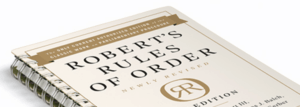Motions
Robert’s Rules of Order is a widely recognized guidebook for conducting meetings and making decisions in an organized and democratic manner. It provides a set of rules and procedures to ensure fair and efficient deliberation and decision-making. Here are some key principles and guidelines related to motions in Robert’s Rules of Order:
- Making a Motion: A motion is a formal proposal made by a member of an organization during a meeting. To make a motion, a member must be recognized by the chair and state, “I move that…” followed by the specific proposal. The motion should be clear, concise, and specific.
- Seconding a Motion: Once a motion is made, another member must second the motion. The purpose of seconding a motion is to show that there is sufficient interest and support for the proposal to warrant further discussion. If no one seconds the motion, it is not considered for further debate.
- Chair’s Restatement: After a motion is made and seconded, the chairperson restates the motion to ensure that everyone understands it. The chair also has the authority to rephrase the motion if necessary to improve clarity.
- Debate and Discussion: Once a motion is on the floor, members can discuss, debate, and express their opinions on the proposal. The maker of the motion typically has the opportunity to present the rationale and arguments in favor of the motion. Other members can then speak for or against the motion. The chair ensures that the discussion remains respectful and orderly.
- Amendments: During the discussion, members have the option to propose amendments to the motion. An amendment is a change or modification to the original motion. To propose an amendment, a member must state, “I move to amend the motion by…” followed by the specific changes. The amendment is subject to debate and requires a second and majority approval to be adopted.
- Voting on a Motion: After sufficient debate and discussion, the chairperson calls for a vote on the motion. There are generally three types of votes: voice vote (members verbally express “aye” or “no”), show of hands, or a ballot vote (secret written vote). The specific voting method is determined by the organization’s bylaws or the chair’s discretion.
- Withdrawal of a Motion: The maker of a motion can choose to withdraw the motion at any time before voting takes place. The withdrawal requires the consent of the assembly or the vote of the majority.
- Point of Order: If a member believes that the rules of order are being violated, they can raise a point of order. The point of order alerts the chairperson to a potential rule violation, and the chair decides whether the objection is valid and takes appropriate action.
These are some of the fundamental rules and procedures related to motions in Robert’s Rules of Order. It is important to note that organizations may have their own specific bylaws or variations on these rules, so it’s always advisable to consult the specific rules and procedures established by the organization you are affiliated with.


